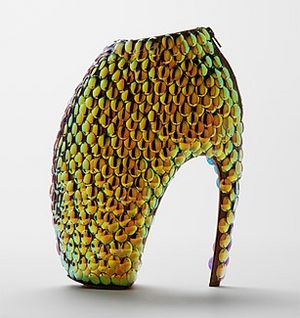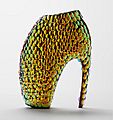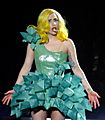Armadillo shoe facts for kids
The armadillo shoe is a very tall, unique platform shoe designed by British fashion designer Alexander McQueen. He created them for his last fashion collection, called Plato's Atlantis, in 2010. These shoes are special because only 24 pairs were ever made. They get their name from their unusual curved shape, which looks a bit like an armadillo.
Each pair of these shoes is about 12 inches (30 cm) tall, with a 9-inch (23 cm) stiletto heel. Because they are so tall, some models found them too difficult to walk in during the fashion show. Famous American singer Lady Gaga wore these shoes many times, including in her 2009 music video for "Bad Romance".
People had strong opinions about the armadillo heels. They are now seen as a very important part of fashion history and McQueen's work. Some people called them strange, while others found them beautiful. Many thought they were too tall and not practical or safe. However, others saw them as amazing pieces of art. Armadillo shoes have even been shown in museums, like the "Alexander McQueen: Savage Beauty" exhibition at the Metropolitan Museum of Art in New York City.
Contents
The Story Behind the Shoes

Alexander McQueen was a British designer famous for his exciting and dramatic fashion shows. He often created imaginative and sometimes surprising designs. Before the armadillo shoes, he had already designed very tall shoes for other collections. These included high platform shoes inspired by Japanese geta and Venetian chopines.
For his Spring/Summer 2010 collection, Plato's Atlantis, McQueen was inspired by climate change and Charles Darwin's theory of evolution. He imagined a future world where humans had to evolve to live underwater after big floods. The collection was shown at Paris Fashion Week in October 2009.
The show started with clothes that looked like land animals, using earthy colors and animal patterns. As the show went on, the designs changed to abstract prints in blue and aqua. This showed the models changing to live in a watery world. The very last outfit, called "Neptune's Daughter", was covered in huge, shiny blue-green sequins. This outfit showed a full change to an underwater environment. Plato's Atlantis was Alexander McQueen's last complete collection.
How the Shoes Look
The armadillo shoes stand almost 12 inches (30 cm) tall, with a 9-inch (23 cm) spike heel. The main part of the shoe curves outwards, like the shell of an armadillo, a lobster claw, or an animal's hoof. Their shape is very unusual in high fashion.
The shoe covers the whole foot, from the ankle to the toes. This makes it look like the person wearing them is walking on their tiptoes, like a ballerina dancing en pointe. But actually, the front part of the foot rests on a hidden platform inside the shoe. Each pair was decorated uniquely to match the animal theme of the collection. Some were covered in python skin or shagreen (a type of rough leather). Others had shiny paillettes that looked like scales.
History of the Armadillo Shoes
Making the Shoes and the Fashion Show
Alexander McQueen first drew his ideas for the armadillo shoes in early 2009. He was inspired by artists like Allen Jones and Leigh Bowery. He asked shoe designer Georgina Goodman to help make his ideas real. Each pair was carved by hand from wood in Italy. It took five days and 30 people to make one pair, using materials from three different suppliers and three factories. The inside lining and outside shell were made separately and then put together. Each section needed two zippers to open. For the first collection, 21 pairs were made. Twenty of these were worn in the Plato's Atlantis fashion show in October 2009.
These shoes were made as special showpieces and were never sold in regular stores. However, many were bought by private collectors after the show. The Alexander McQueen Archive in London owns at least five pairs. The Metropolitan Museum of Art in New York City owns two pairs.
Walking in these shoes was very hard. The show's producer tried them the night before and found it impossible to walk. When he told McQueen that models might fall, the designer simply said, "If they fall, they fall." Because of safety worries, models Abbey Lee Kershaw, Natasha Poly, and Sasha Pivovarova chose not to walk in the show. Model Magdalena Frąckowiak later said walking in them was "really frightening." Even with these concerns, no models fell during the show, which many in the fashion world thought was "miraculous." McQueen himself later said he had never tried walking in the armadillo shoes. He cared more about how the shoes looked than if they were easy to wear. He once said, "The world needs fantasy, not reality. We have enough reality today."
Famous People Wearing Them
Many celebrities have worn armadillo heels for special events and photoshoots.
American singer Lady Gaga first showed her 2009 song "Bad Romance" at the Plato's Atlantis show. For the song's music video, released in November 2009, Gaga wore the shiny "Neptune's Daughter" outfit, including the matching armadillo shoes. She also wore a pair of python-skin armadillo heels when she arrived at the 2010 MTV Video Music Awards in September 2010. She later said this was her favorite outfit ever. That same month, she wore the same shoes with a dress made of hair for a performance in New York.
In 2015, three brand-new pairs of armadillo shoes were made by McQueen's company. They worked with Christie's auction house to sell them to raise money for UNICEF. The money helped people affected by the April 2015 Nepal earthquake. The shoes were expected to sell for about $10,000–$15,000 each. But they ended up selling for a total of $295,000! All three pairs were bought by American actor Taylor Kinney, who gave them to Lady Gaga, who was his fiancée at the time. In 2016, Gaga was a guest editor for V magazine, which featured a photoshoot of her wearing armadillo heels.
In 2019, Kerry Taylor Auctions reported selling a pair of turquoise armadillo heels for £60,000 (about $75,000).
Images for kids
-
A dress from Plato's Atlantis on display at the Victoria and Albert Museum, 2015








